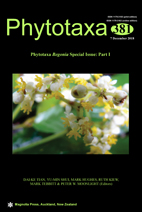Abstract
A new species, Begonia ehuangzhangensis, from Yangchun City, Guangdong Province, China, is described and illustrated. Morphologically, B. ehuangzhangensis is most similar to B. fimbristipula in tuber shape, leaf number, and placentation type but significantly differs by indumentum characters of petiole and blade, tepal number of male flower, flower size, capsule size, and flowering period. Begonia ehuangzhangensis also resembles B. rongjiangensis in plant shape, number of tepals, placentation type, and flowering period, differing by indumentum characters of ovary, bract and outer tepals of male flower, flower size, shape of stigmas, leaf number, and leaf margin.

